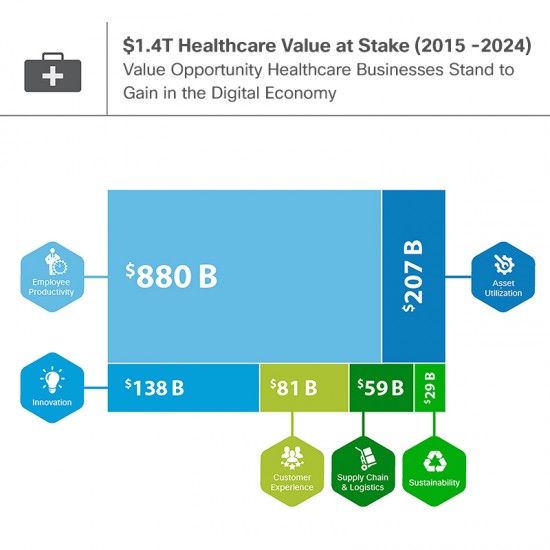Last week I wrote about how digital fans are expecting new experiences at NCAA games as part of March Madness. (Wow – how about some of those games this weekend – and my Fighting Irish survive and advance to the Sweet 16! But I digress…)
This week I want to look at another topic—a much more important one.
Healthcare. We all need it. It’s right up there with death and taxes on life’s list of inevitabilities. And while the rising cost of healthcare has been slowing from the torrid rates of a few years ago, according to an article in CBS MoneyWatch, overall U.S. health costs are still expected to climb 6.5 percent in 2016—more than three times the rate of inflation. The United States isn’t alone. Healthcare systems around the world are wrestling with the challenge of managing costs while delivering quality care.
The good news is that a broad range of digital solutions is making healthcare less expensive and more accessible. In fact, last year private sector hospitals and pharmaceutical companies globally realized $67 billion in digital value, according to a recent Cisco analysis. The bad news? This represents only 16 percent of what they could have generated in 2015. The industry walked away from 84 percent—or $350 billion—in potential value. Clearly, our healthcare systems can do better.
There is a tremendous opportunity to create digital value over the next decade. Cisco’s analysis identified 31 digital use cases with the potential to drive $1.4 trillion in private sector healthcare value from 2015 to 2024 (see Figure 1). This “value” translates directly into the industry’s ability to serve more patients, improve the quality of care, and reduce healthcare costs.

Healthcare providers must balance a long list of urgent priorities: reduce operational costs, improve the quality and efficiency of care, decrease inpatient volume, shift from volume- to value-based reimbursement, and improve relationships between clinicians and administrators. Electronic health records, mobile apps, telehealth, and social media are some of the patient-friendly technologies that address these concerns.
Telehealth is an important case in point. It can save money and extend services—but also save lives. The telehealth program at Lucile Packard Children’s Hospital in Palo Alto, California, helps fill the gap in rural areas that have a shortage of pediatric specialists. With high-quality video conferencing, instant access to patient records, and network-connected medical devices, the hospital’s virtual visits provide care for 300 pediatric patients. The hospital is also a part of the Virtual Pediatric Network, which uses advanced collaboration technologies to help physicians across the country work together on difficult cases.
Pharmaceutical companies face a different array of issues. Like other manufacturers, they must fend off low-cost competitors, improve supply chain management, and increase production efficiency. To bring new drugs to market faster and more cheaply, they also need to manage all kinds of data more effectively. Data analytics, social media, cloud, and mobility play an essential role in improving customer engagement, developing personalized medicines, collaborating seamlessly with new partners, and reaching new markets.
Some of the biggest sources of digital value are not unique to healthcare. Areas like cybersecurity, payments, and connected marketing drive 86 percent of Digital Value at Stake. The largest of these categories, next-generation workers, uses many of the same technologies that make telehealth possible. They can make all healthcare workers—not just physicians—more productive, to the tune of $838 billion over the next decade.
You may be wondering what’s new about all this. After all, people throughout the healthcare industry have been working on digital transformation for years. That’s true, but now we’re at a tipping point. The array of digital technologies available can fundamentally change healthcare processes, systems, and business models—for the better. This comes not a moment too soon.
Death and taxes may be inevitable worries, but if we get this right, healthcare won’t be.
To find out more about Digital Value at Stake in healthcare and five other private sector industries, read our full report, “Where To Begin Your Journey to Digital Value in the Private Sector.”
Awesome article – 2 of my top passions…Healthcare and Tech. The face of healthcare has changed drastically over the past 10 years and it’s exciting to see the role that Cisco plays in that transformation. My last doctor visit was virtual (thank you Cisco!) and painless (no driving, no waiting in a germ ridden waiting room). Even my medication was delivered to my doorstep. What this means for thousands of people worldwide that are housebound or in remote locations in transformational.